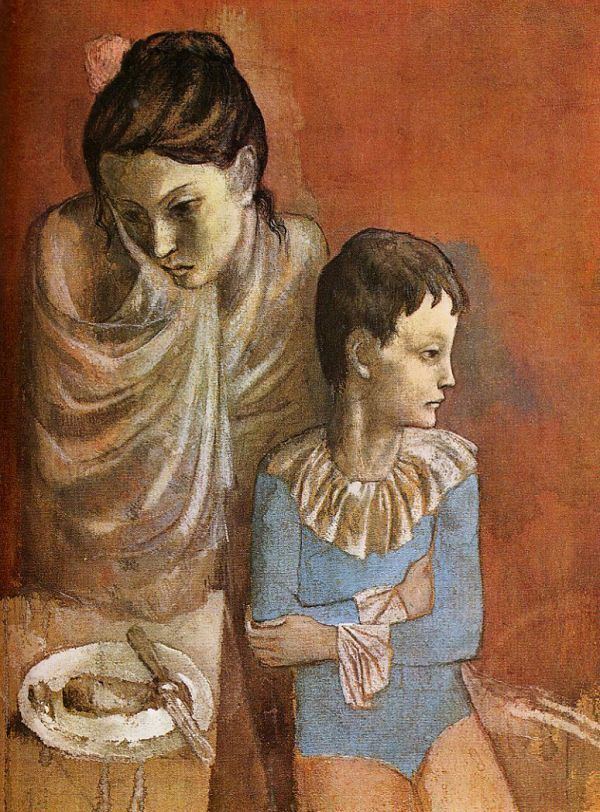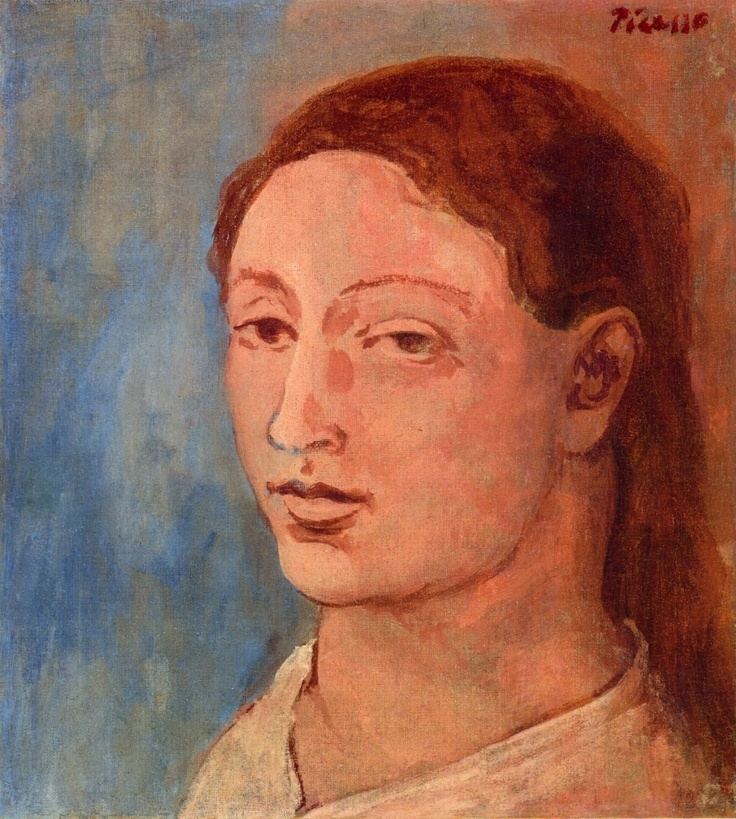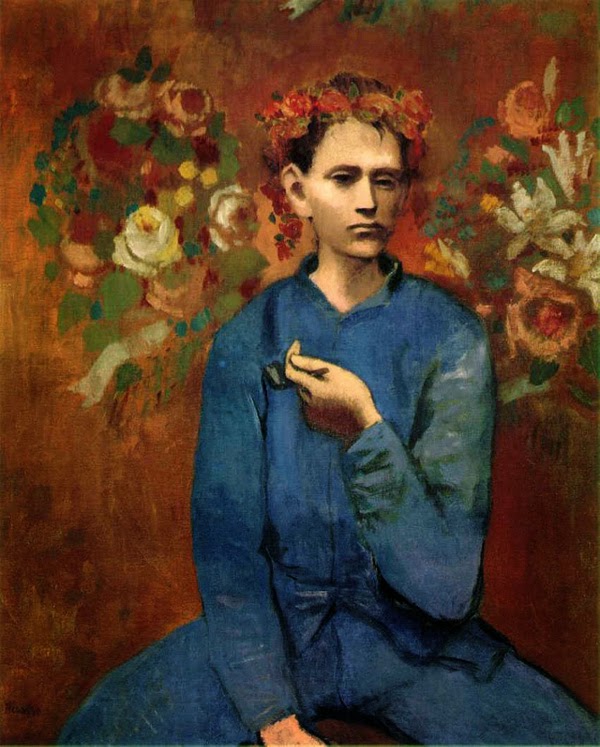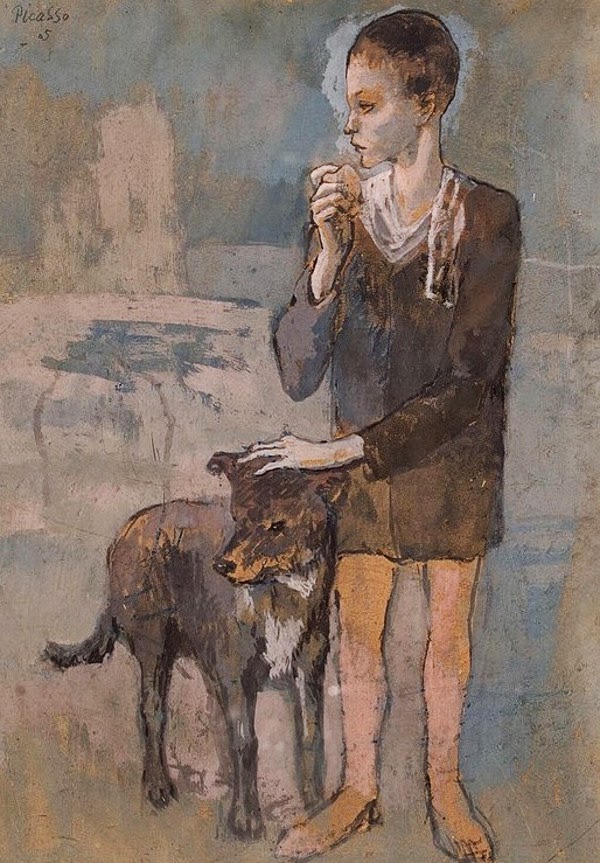
pablo picasso Pablo picasso artwork, Picasso artwork, Picasso art
In these two art lessons my students created delightful flowers and hearts inspired by Picasso's Rose Period. Students created a big flower on 18″ x 18″ sheets of tagboard with tempera paint. It took 50 minutes to complete one large flower. We let them dry and then cut them out. Students used a piece of 18″ x 18″ tagboard, drew a.

Cubist Portrait of Pablo Picasso The Rose Period Art Print by Taiche Cubist portraits
The Rose period lasted from 1904 to 1906. This period mainly showed the rise of Pablo Picasso in his new style and how he experimented with primitivism. In addition, he began to be deeply interested in African art in this period, and this interest formed the first stage of bringing a new style to his art in the following period.

Picasso's Rose Period Hearts Love Picasso rose period, Art lessons, Art
The Rose Period (1904 - 1907) was characterized by a soft, pastel color palette. In addition to the colors, Picasso changed the marginal characters of his blue period for other marginal characters: the artists of the Medrano circus in Montmartre. These artists were no longer desperate like the anguishing blue characters, but they did not.

Picasso's Rose Period Detailed Information Photos Videos
In Picasso's work, the Rose Period was relatively short (from the fall 1904 until the end of 1906) and quite uneven. A large number of pictures were marked with a bright color; we see the advent of pearl gray, ocher, pink and red tones; there appeared new topics, such as actors, acrobats, athletes, and became dominant.

Picasso's Rose Period Detailed Information Photos Videos
The Rose Period comprises the works produced by Spanish painter Pablo Picasso between 1904 and 1906. It began when Picasso settled in Montmartre at the Bateau-Lavoir among bohemian poets and writers. Following his Blue Period - which depicted themes of poverty, loneliness, and despair in somber, blue tones - Picasso's Rose Period represents more pleasant themes of clowns, harlequins and.

Picasso Portrait The Rose Period Canvas Print / Canvas Art by Taiche Acrylic Art Cubist
Other articles where Rose Period is discussed: Pablo Picasso: The move to Paris and the Rose Period:.to 1906 in the so-called Rose Period by those of pottery, of flesh, and of the earth itself (The Harem [1906]). Picasso seems to have been working with colour in an attempt to come closer to sculptural form, especially in 1906 (Two Nudes; La Toilette). His Portrait of Gertrude Stein…

Harlequin on the horseback, 1905, Pablo Picasso Size 100x69.2 cm Medium oil on cardboard
The Evolution of Picasso's Painting Style and What Each Artistic Choice Represents. Throughout an artist's lifetime, changes in approach, subject matter, and even style are to be expected. This phenomenon is apparent in the evolution of modern art 's most beloved painters, from Monet 's move toward abstraction to Van Gogh 's brightened.

Picasso's Rose Period Detailed Information Photos Videos
The Rose Period of Picasso lasted from 1904 to 1906 This period signifies the time when the style of Pablo Picasso's painting used cheerful orange and pink colors in contrast to the cool, somber tones of the previous Blue Period. During these few years, Picasso was happy in his relationship with Fernande Olivier whom he had met in 1904 and this.

Picasso Picasso art, Picasso rose period, Pablo picasso art
Falling in love with Fernande Olivier, Picasso started to use cheerful orange and pink colours after a four-year period of melancholy(1901-1904). Harlequins,.

The 25+ best Picasso rose period ideas on Pinterest Pablo picasso periods, Picasso blue and
In addition to the poverty in which he lived, the death of his friend devastated him and he began a series of paintings tinted blue, a color associated with deep melancholy. "Blue Self-Portrait", dating from 1901 and kept at the Musée National Picasso-Paris, is a testimony to the painter's state of mind.

Picasso Rose Period Hearts and Flowers Painted Paper Art
The Rose Period was for Pablo Picasso an important time in his life and work as an artist. While it only lasted for a short while (1904 to 1906), it was a time of great artistic worth. It led to Picasso forming the style that would see him become one of the foremost artists of the 20th century. 1904 was the year that saw the start of Picasso.

Art et glam Pablo Picasso, sa période rose
About the work. Picasso's Rose Period represents an important epoch in the life and work of the Spanish artist Pablo Picasso and had a great impact on the developments of modern art. It began in 1904 at a time when Picasso settled in Montmartre at the Bateau-Lavoir among bohemian poets and writers. Following Picasso's Blue Period, depicting.

Cheers to all pink hues and Picasso’s rose period Irmas World
By 1904, Picasso had traded the blue palette and bleak subject matter of his Blue Period for a predominantly red, pink, and orange palette. This period accordingly became known as the Rose Period (1904-1906). With his Rose Period, Picasso favored a lighter, warmer color palette, subtle use of line, idealized forms, and more spirited subjects.

Der frühe PICASSO Blaue und Rosa Periode Fondation Beyeler
The Rose Period started in 1904, a year in which Picasso alternated paintings in the "blue style", dark colored (often blueish) and downbeat, with paintings made in his "rose style", which are somewhat more optimistic in mood and brighter colored (often using the color pink). So 1904 is a transitional year and belongs neither truly to the blue.

Art et glam Pablo Picasso, sa période rose
The Rose Period (1904-1906) is characterized by a lighter tone and style utilizing orange and pink colours, and featuring many circus people, acrobats and ha.

Pablo Picasso werken, stijlkenmerken. Kubisme van Pablo Picasso
What Makes a Picasso Rose Period? Tumblers (Mother and Son) by Pablo Picasso c. 1905 courtesy Staatsgaleria, Stuttgart. The year 1904 marked a significant turning point in Pablo Picasso's artistic journey, as he began reintroducing color into his paintings after the monochromatic intensity of his Blue Period. This shift signaled a departure.